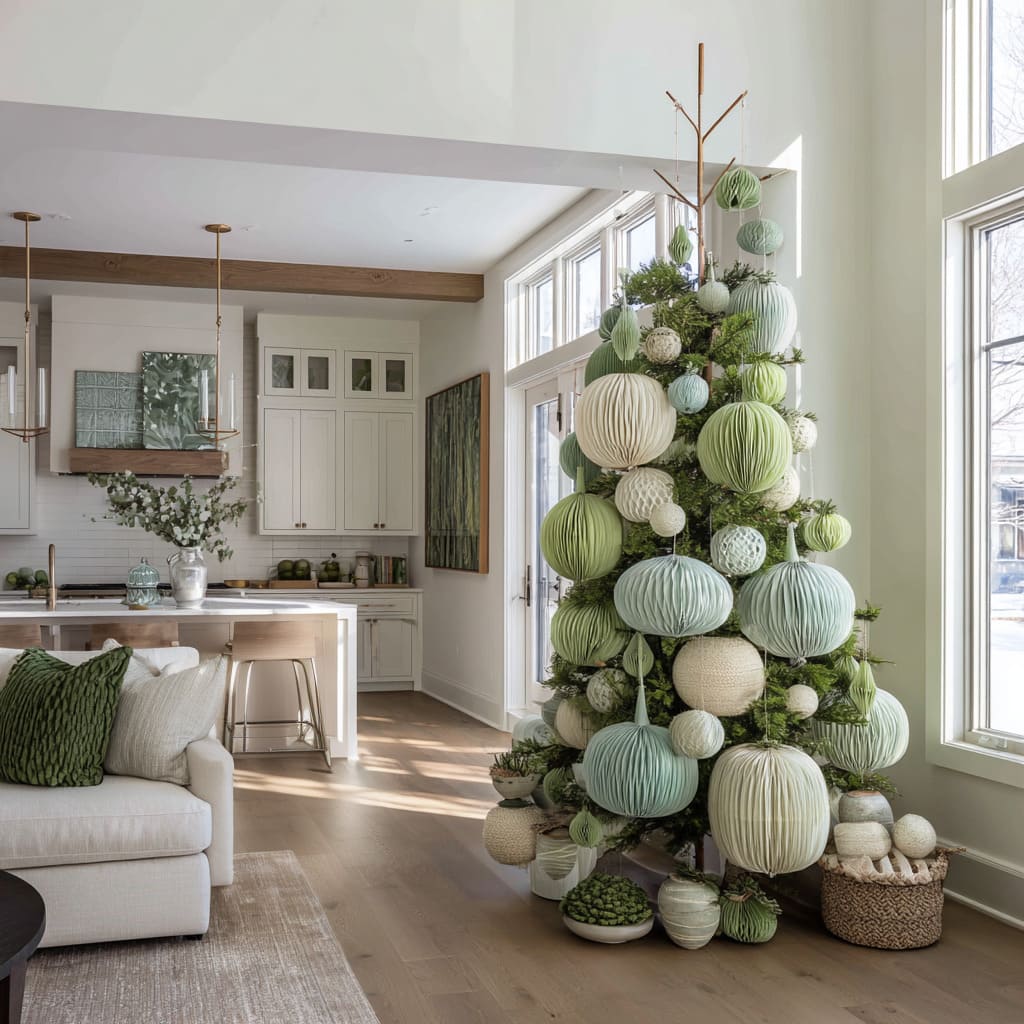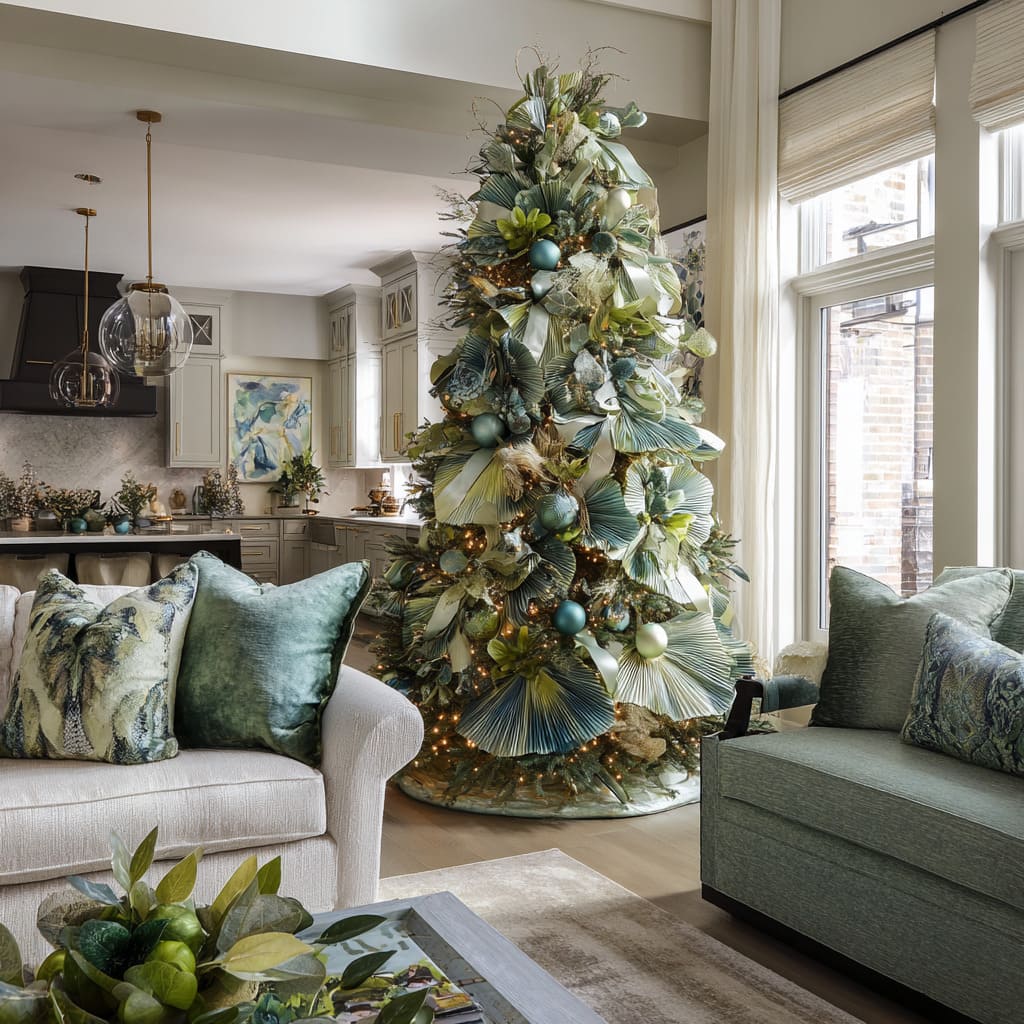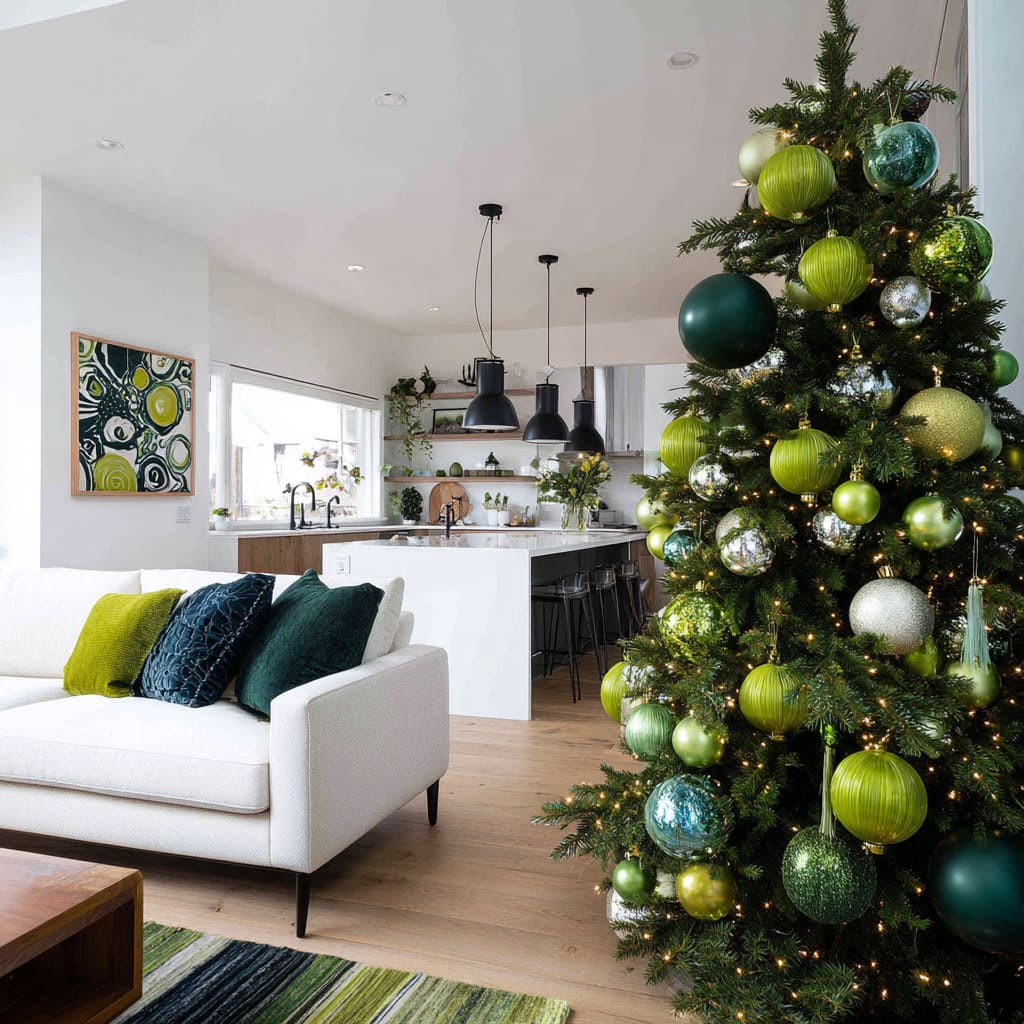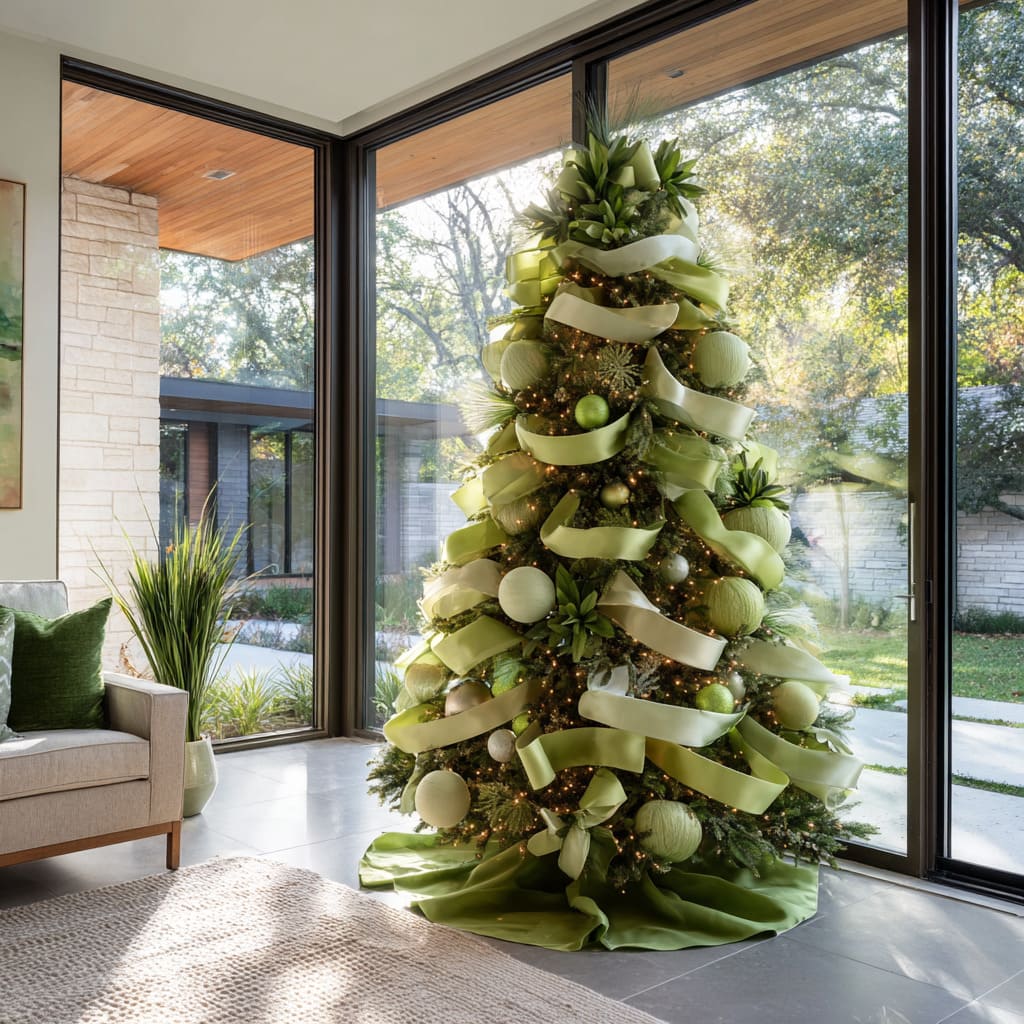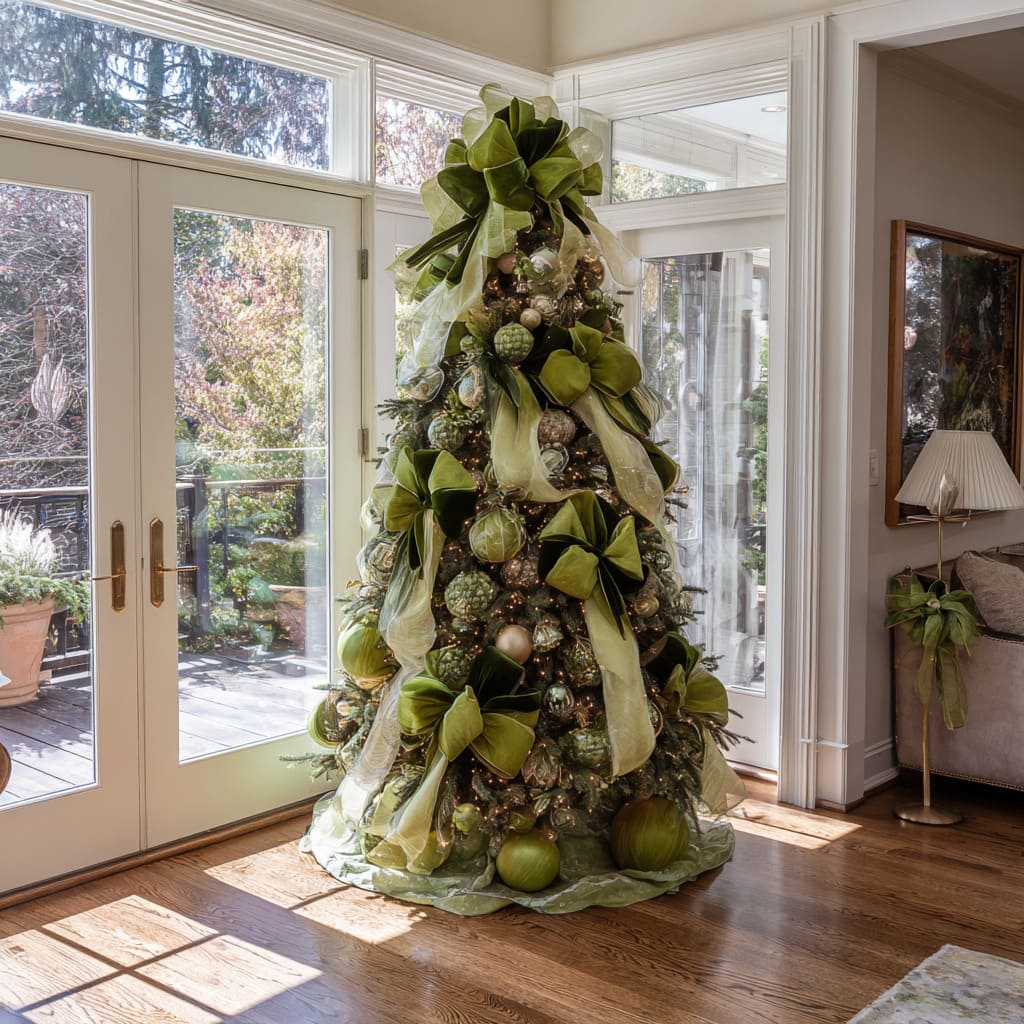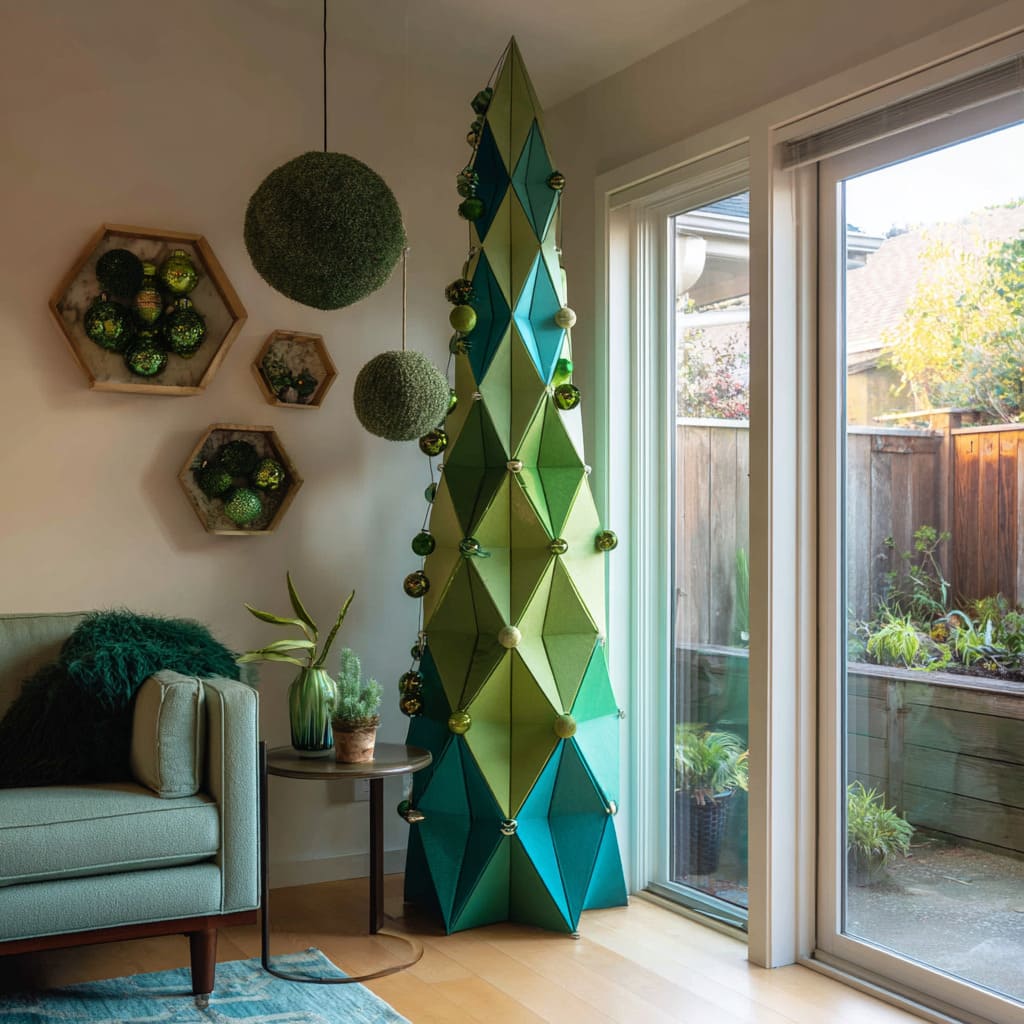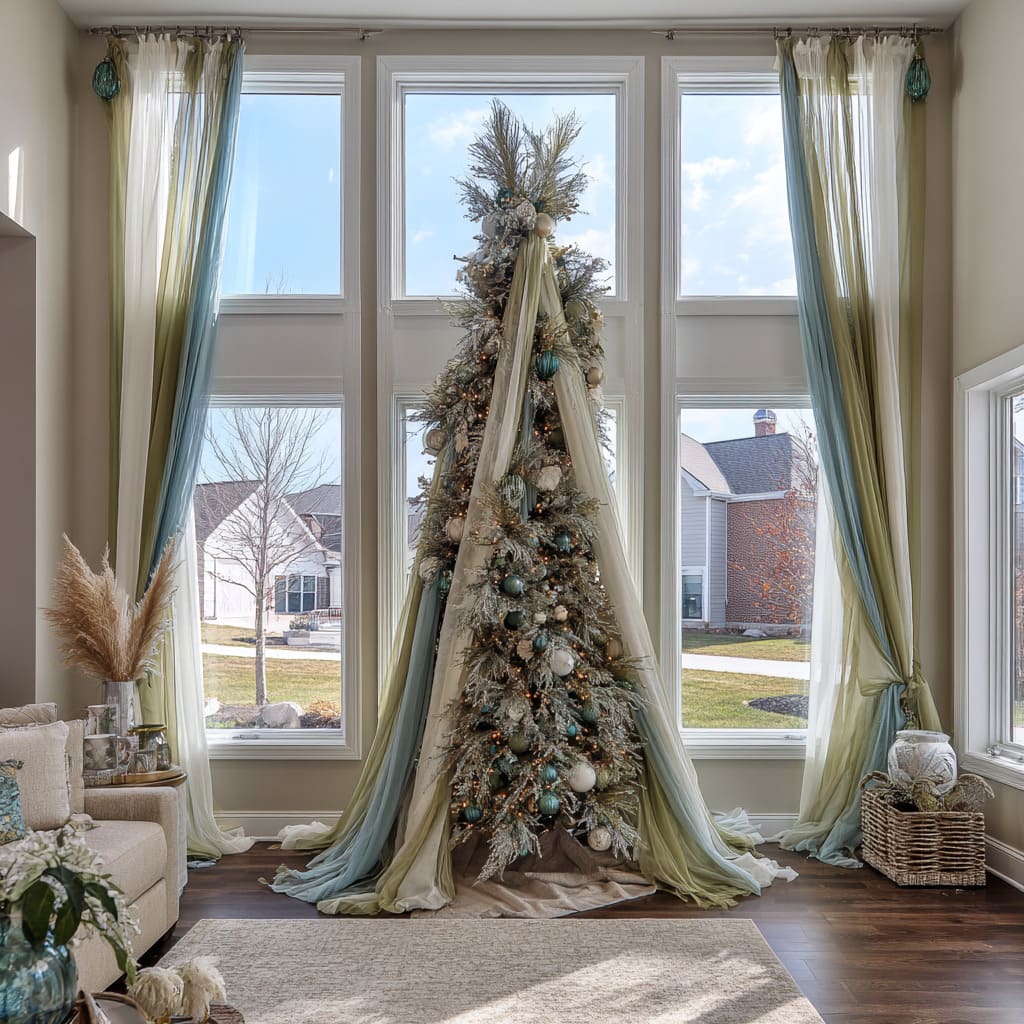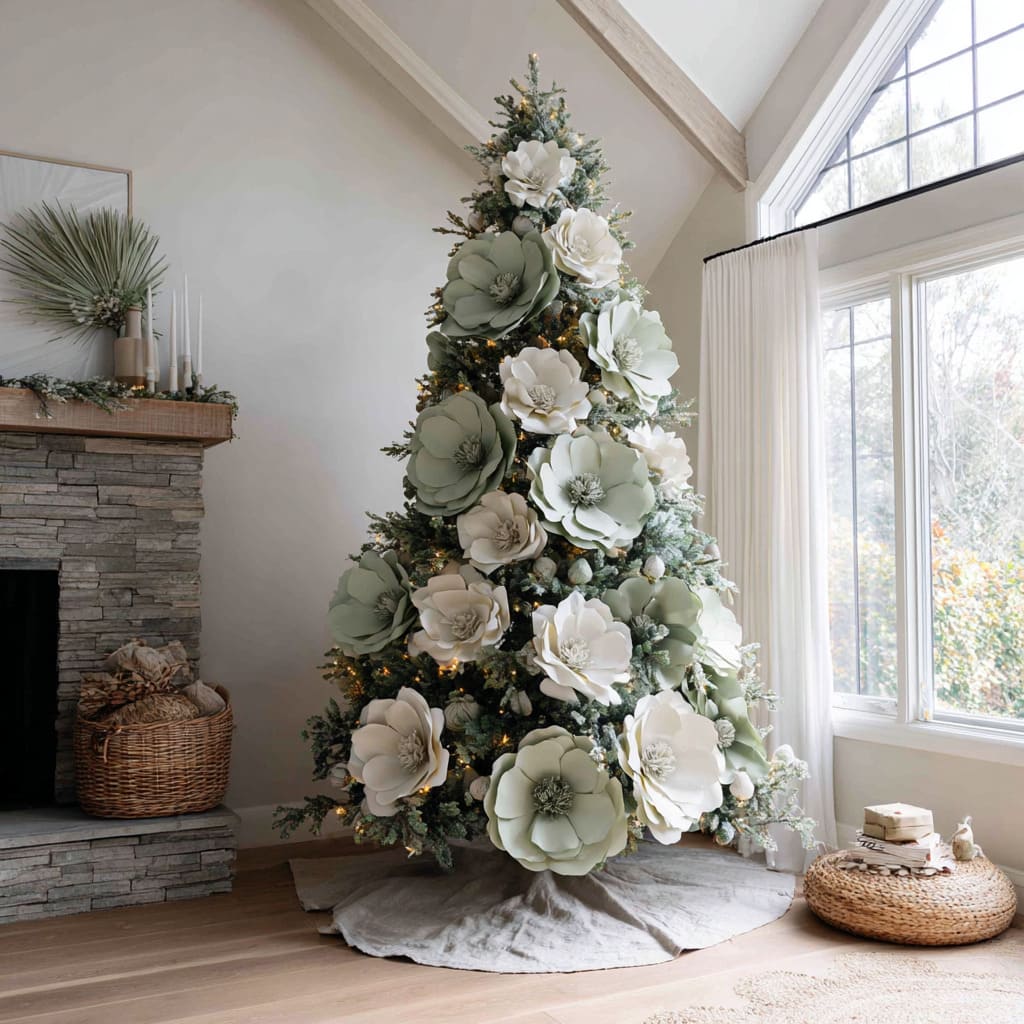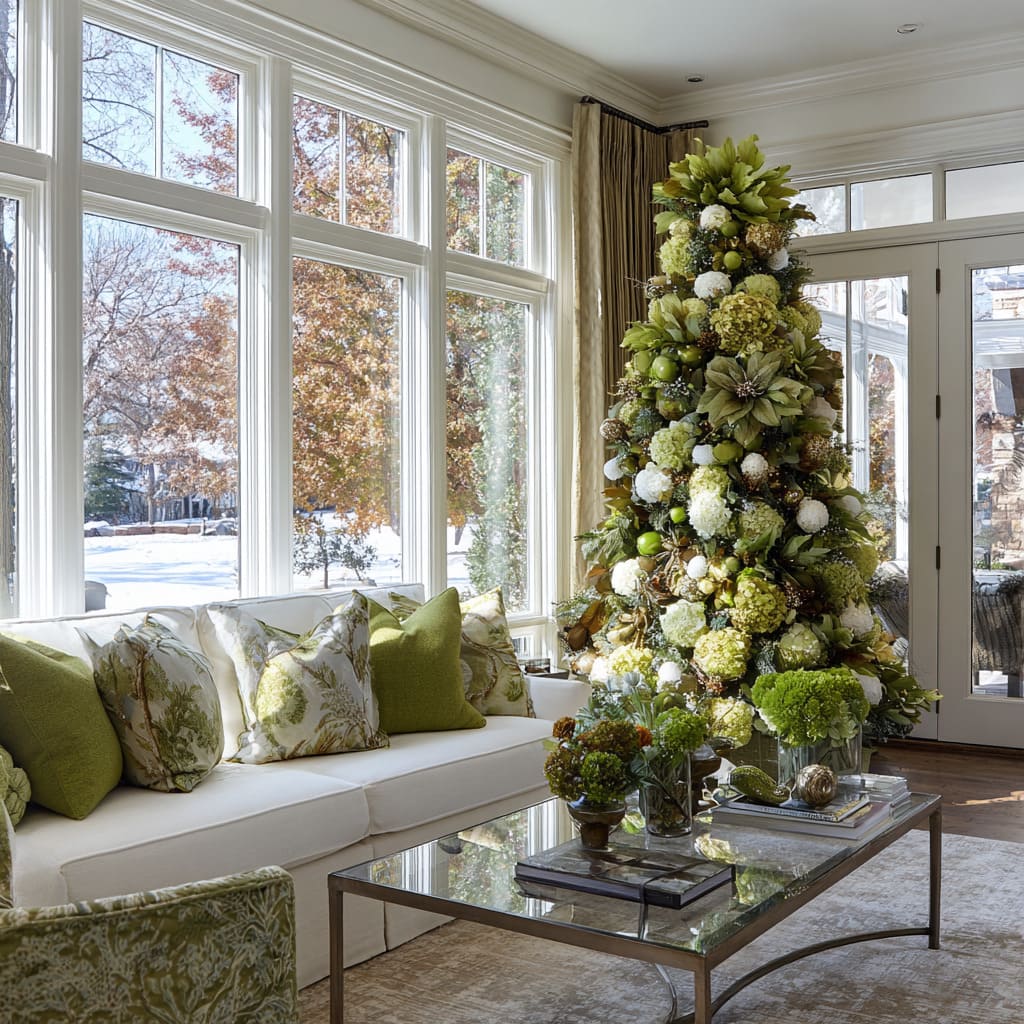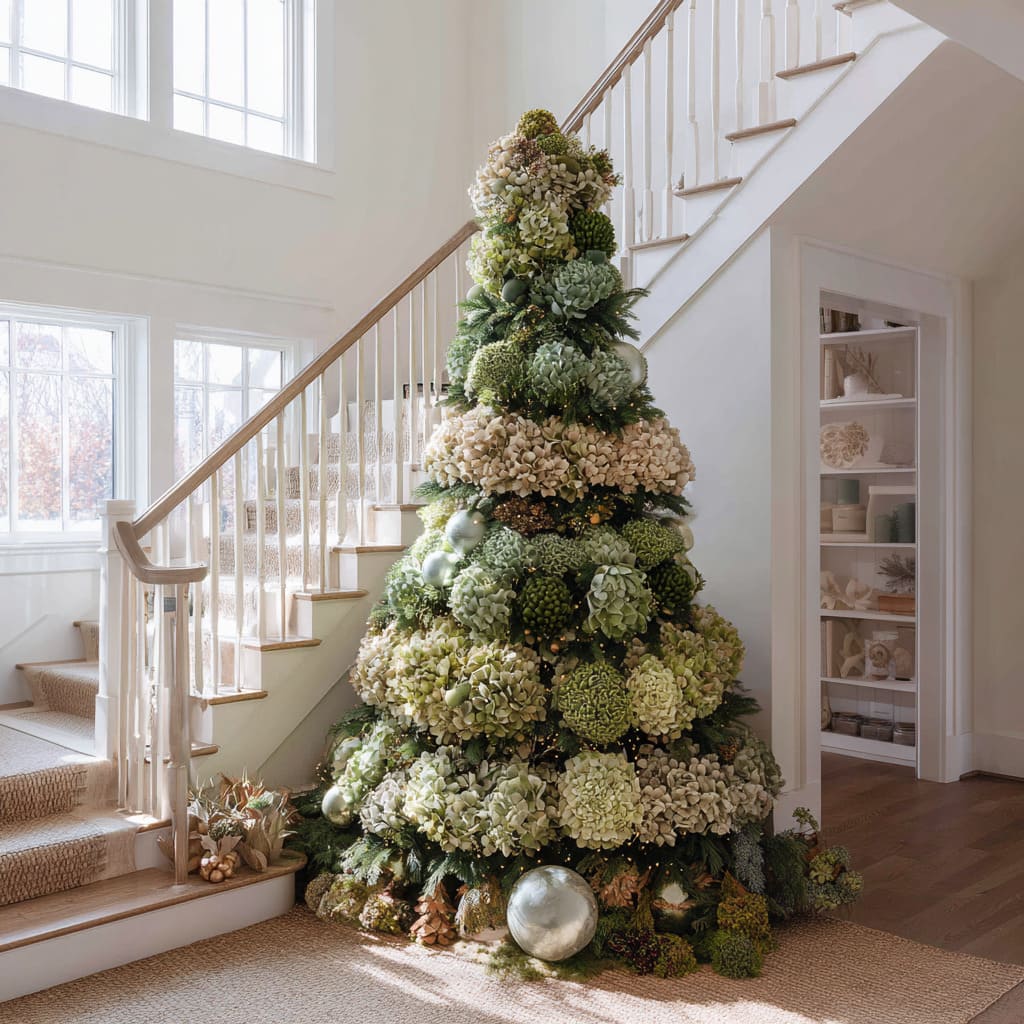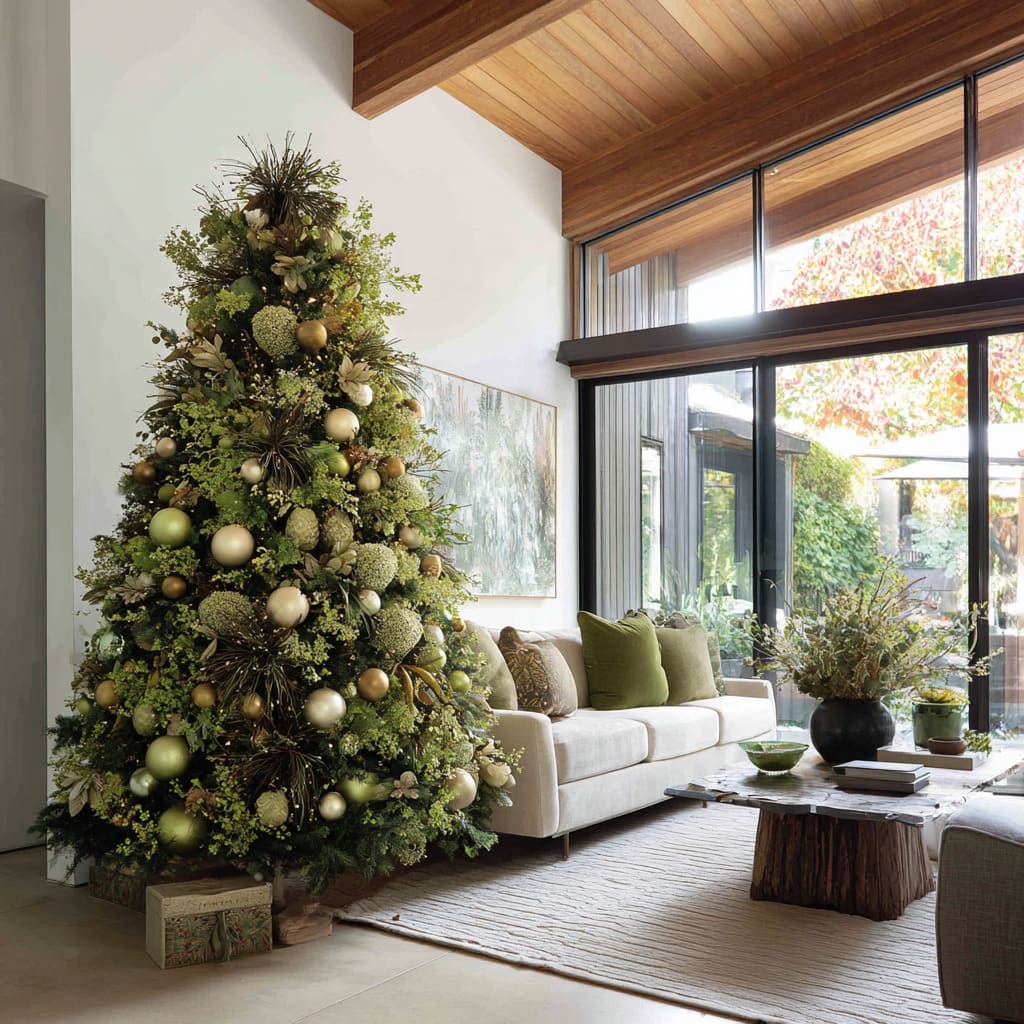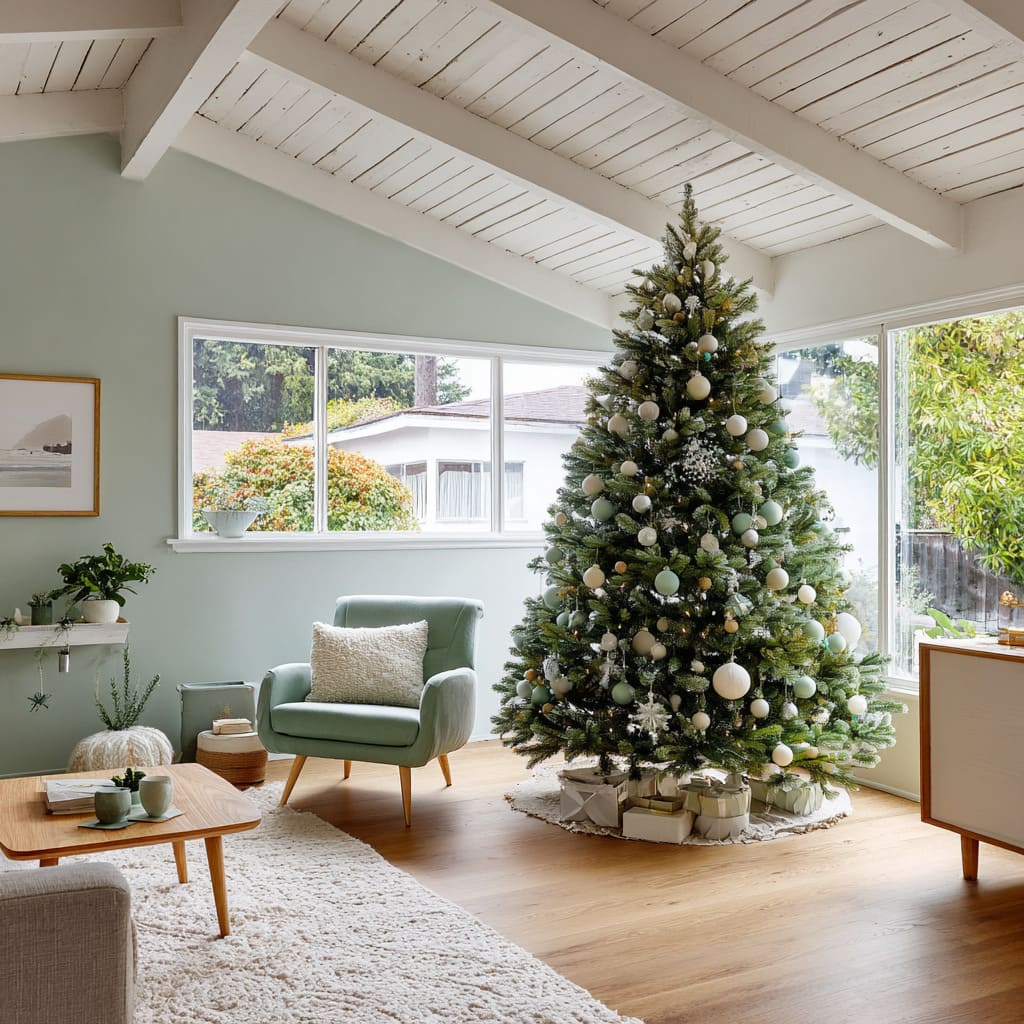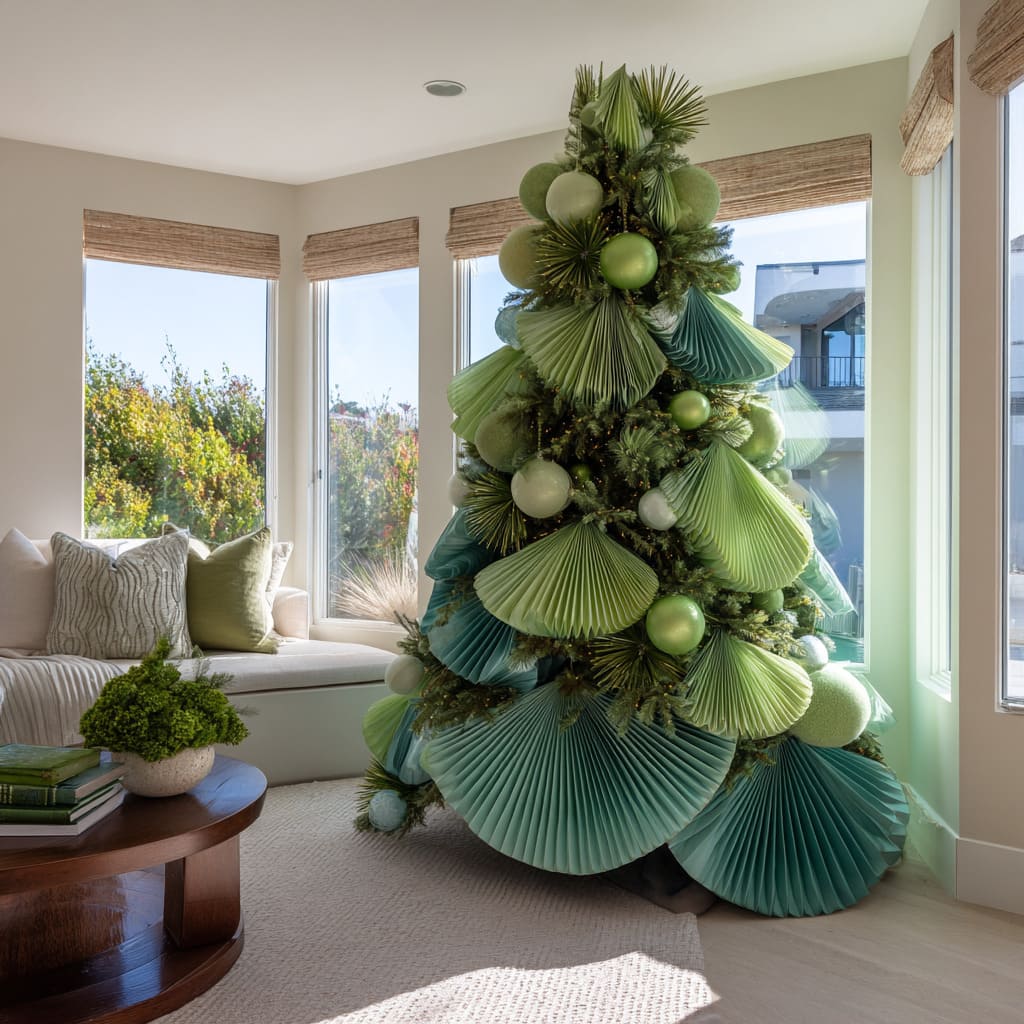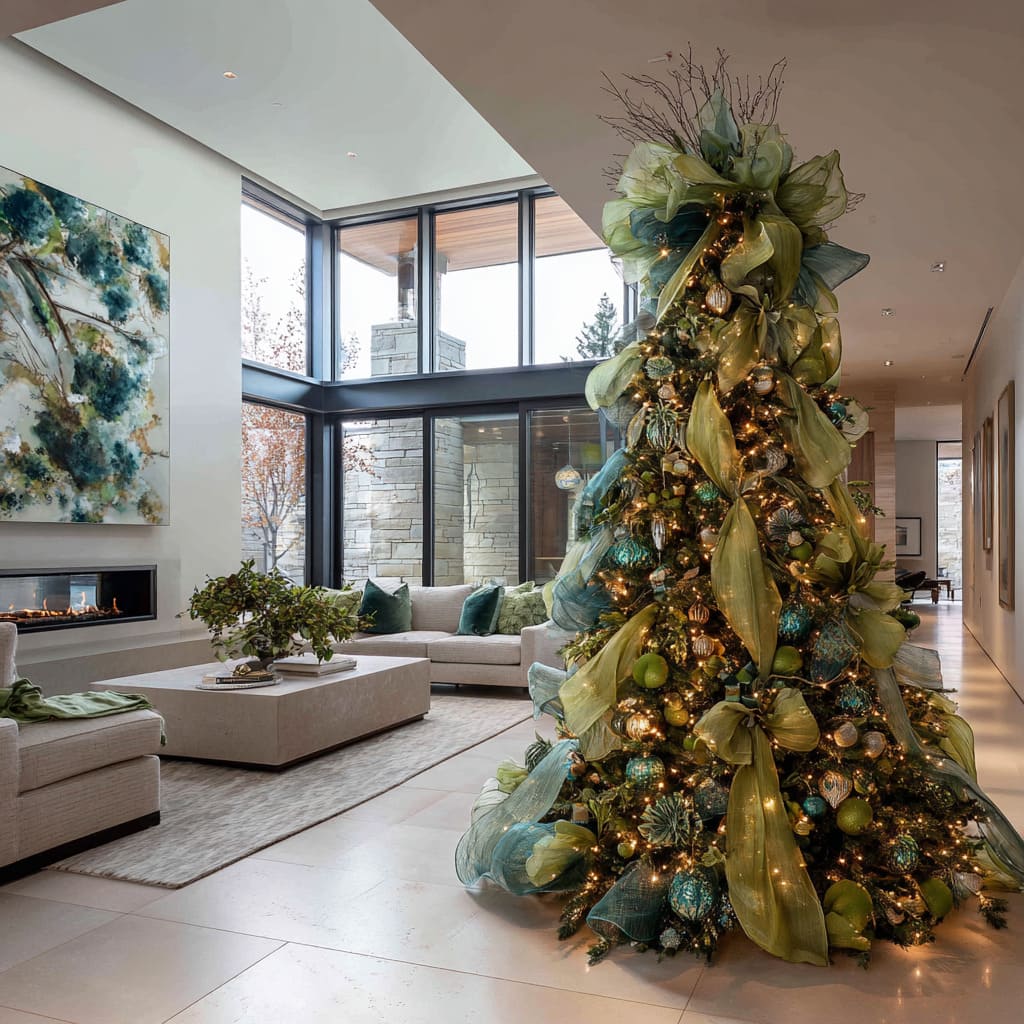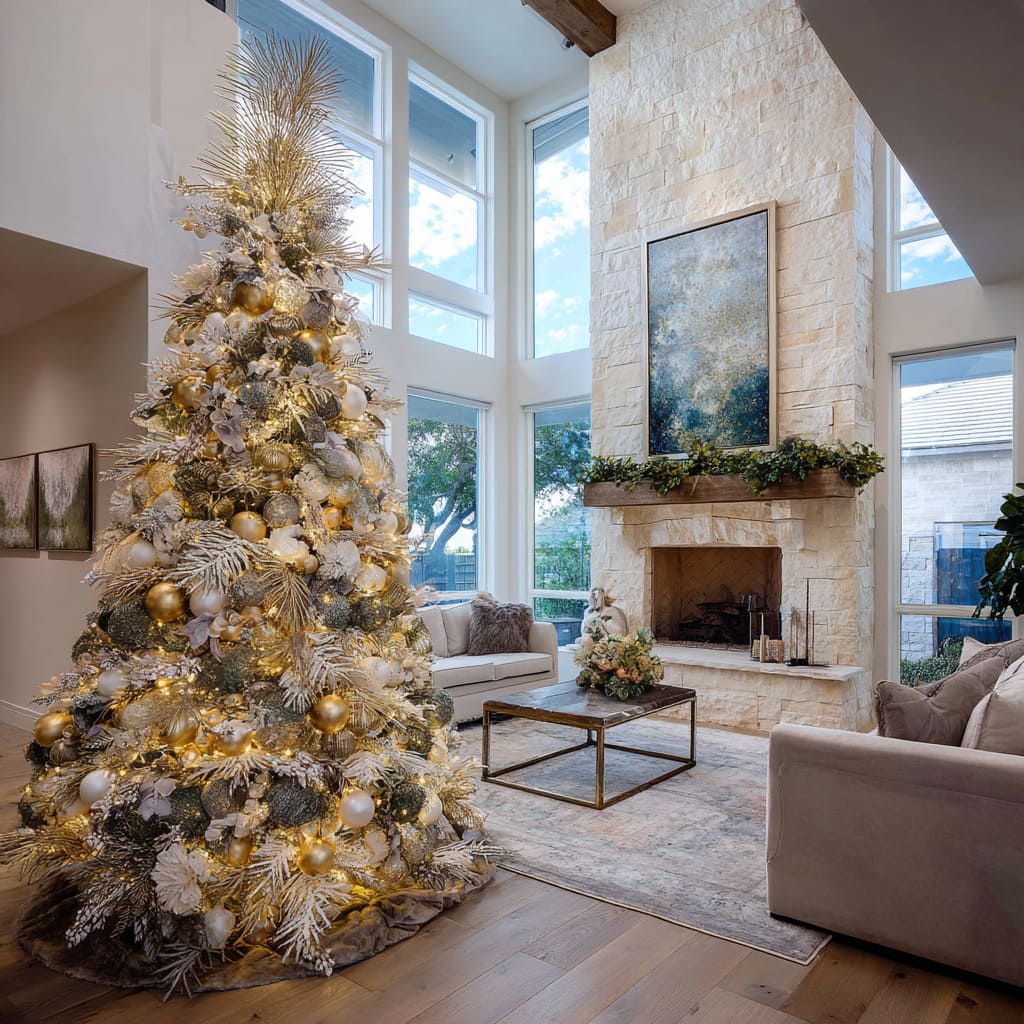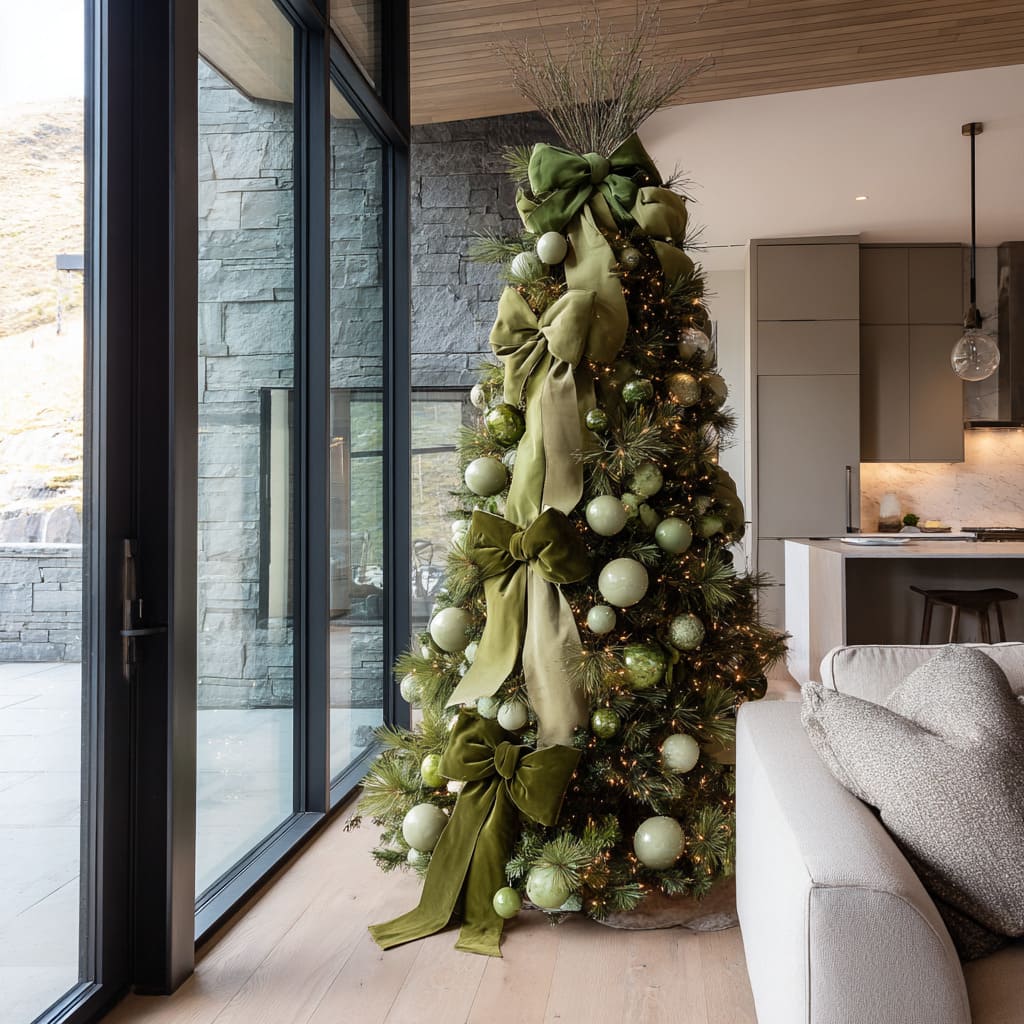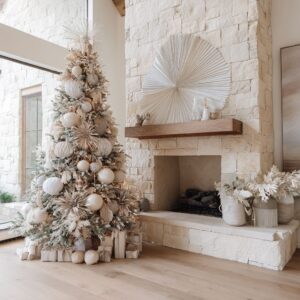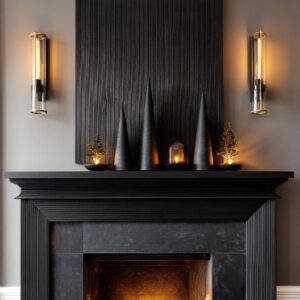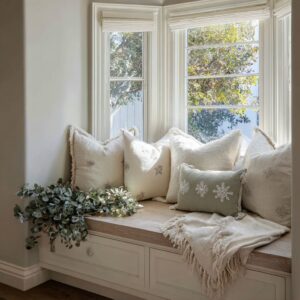Green Christmas decorating ideas often look simple on the surface, yet in well-designed concepts, the color turns into a complete visual system that shapes flow, mood, and balance. Instead of acting as a seasonal accent, green becomes a link between everyday decor and holiday styling.
The biggest shift happens when the tree echoes tones already living in the room design—greens in cushions, ceramics, area rugs, or even outdoor foliage. When the palette feels familiar, the tree blends into the space as a vertical continuation of existing colors.
This approach works especially well in open interiors where the tree sits near kitchen shelving, living-room textiles, or window plants. The most interesting effect is that the tree feels quietly woven into the home rather than added onto it.
Even when the ornaments vary in finish, the constant presence of green stabilizes the composition, giving the entire scene a sense of visual steadiness that is soft, calm, and unforced.
Palette Depth: How Shades of Green Change Mood and Atmosphere
One of the least obvious layers in green Christmas tree ideas is the use of undertones to set the emotional tone. A room filled with soft sage, dusty mint, and pale celery feels extremely gentle, while a scheme built around deeper moss, pine, and bottle green creates warmth and presence.
A tree stays visually rich when greens fall along a range rather than sitting at one point on the spectrum.
Three common undertone strategies emerge:
- Cool, gray-leaning greens that merge with daylight and snow-inspired tones.
- Warm, slightly golden greens that pair well with natural wood or muted brass.
- Crisp lime or seafoam sparks used sparingly to keep the palette lively.
Because surface finishes differ—matte petals, ribbed glass, smooth baubles—the undertones shift subtly across the tree, giving even a monochrome palette a soft internal rhythm. This layer of color control is what makes the design feel thoughtful instead of repetitive.
Architecture as the Silent Partner in a Green Holiday Palette
Green Christmas tree decoration ideas become more compelling when the tree interacts with the room’s structure. In large spaces with tall windows, the tree can often align with horizontal breaks in the glass or soften the strong vertical push of ceiling height.
In open layouts, the tree naturally defines the boundary between lounging and dining areas without blocking circulation. They often position the tree where the architecture needs a soft focal point—a line where two functional zones meet, a wide corner that feels empty, or a tall expanse of glass that requires warmth.
Lists like the one below help show how green relates to structure:.
How trees interact with space
- Soft dividers along kitchen–living transitions
- Height balancers under tall glass or stone walls
- Palette connectors placed between window views and interior color stories
- Shape softeners in rooms with strong angles or large square volumes
This architectural awareness is what grounds the tree visually. The green tones don’t just complement the ornaments—they answer the room’s proportions.
Repeating Shapes as the Core Design Strategy
Christmas tree decorating ideas in green succeed most when the surface is shaped by one repeating form. Instead of mixing dozens of ornament styles, designers often choose a single shape system and let it define volume.
Common shape systems include:
- Sphere-based structures using ribbed lantern forms, large smooth globes, and soft matte balls that give the tree a cloud-like shape.
- Petal and blossom systems where magnolia petals, hydrangea clusters, and botanical mounds create soft tiers reminiscent of garden borders.
- Pleated fan and disc systems where radial folds catch light in slices, giving structure through texture rather than sparkle.
- Geometric panel systems where triangles or angled planes behave almost like an origami installation.
These systems influence how the tree holds space. A sphere-based composition feels gentle, while fan-shaped or geometric systems feel structured and sculptural.
The shape language becomes more influential than ornament color, proving that the tree’s silhouette plays a bigger role than people expect.
Light Placement
A major insight behind Christmas tree ideas for green tree styling is how lights sit inside the branches. When bulbs nest deeply rather than sitting on the outer layer, the tree gains depth, shadow, and a warm internal glow.
This lighting strategy allows reflective ornaments to capture soft highlights without producing harsh points of brightness.
The relationship between light and daylight matters as well:.
- Warm inner light softens cool outdoor light coming through windows.
- Pleated surfaces glow at the edges.
- Frosted ornaments pick up highlights that feel misty and gentle.
- Deep greens warm up when placed near yellow-gold bulbs inside the tree.
Daylight passing through sheer ribbons or draped fabrics creates additional layers of illumination. The results feel atmospheric and soft, with the tree behaving more like a glowing sculpture than a bundle of bulbs.
Palette Echoing
One of the strongest visual moves in emerald green Christmas tree decorating ideas is palette echoing—where green appears across the room in multiple textures, not just on the tree. Upholstery, drapery, ceramics, artwork, cushions, and dried botanicals all carry versions of the same green.
A living room might include mossy pillows, a leafy print on the wall, a green vase, and a tree built from petal clusters of similar tones.
Palette echoing works through:
- Material diversity: velvet, matte ornaments, paper fans, glass, and soft fabrics
- Repetition across surfaces: cushions, art, ribbon, branches, textiles
- Gradient placement: darker tones toward the center, lighter tones toward the outer edges
The effect is a visual loop. The tree links the decor together, and the decor supports the tree.
This keeps even very dramatic trees from feeling out of place, because the palette gains support from the room itself.
Nature as Partner: Indoor Green and Outdoor Landscape
In rooms with wide windows or scenic views, the tree can become part of a dialogue with nature—especially in snowy or mountainous regions or homes with garden views. The outdoor tones guide the choice of greens on the tree.
Frosty sage works well with pale skies or snowy ground, while deeper greens hold up against dark stone, tall woods, or evergreen scenery.
Key ways trees respond to landscape:
- Echoing outdoor lines such as hillsides, fronds, or bare branches
- Using botanical clusters to mimic garden textures
- Choosing green undertones that blend with the surrounding climate
- Aligning height with window frames so the tree integrates with the view
This creates the impression that the holiday decor is an extension of the landscape rather than an indoor add-on. The green becomes a bridge between interior comfort and the outside world.
Fabrics and Textures: How Soft Materials Transform Green
Many green Xmas tree ideas rely on the tactile richness of fabric—velvet bows, sheer drapes, wide ribbons, and textile clusters. In these compositions, fabric becomes more important than the ornaments themselves.
Velvet absorbs light, sheer fabric diffuses it, and draped cloth around the base creates a relaxed pool of texture.
How fabric transforms the tree:
- Velvet gives depth and softness
- Sheer fabric creates flowing lines and airy movement
- Draped bases blend the tree into the floor
- Layered ribbons shape the silhouette rather than decorate it
Where ornaments might feel rigid or shiny, fabric introduces ease and calm. When placed carefully, it directs the eye around the tree like a series of soft paths.
Botanical Structures: Turning the Tree Into a Living Garden
Some of the most distinctive green Christmas tree ideas can use botanical forms—hydrangea mounds, magnolia petals, palm leaves, pods, and dried stems—to create depth and variety. Instead of being decorative extras, these elements become the structure of the tree.
Botanical surface systems:
- Hydrangea tiers creating horizontal layers
- Magnolia petals forming rounded shapes that replace traditional ornamentation
- Palm fronds adding broad, tropical sweeps
- Seed pods and dried stems grounding the design with earthy tones
The result resembles a sculpted garden rather than a classic holiday tree. This approach blends winter décor with plant-based forms, making green feel natural, tactile, and layered.
Scale and Proportion
In expansive interiors with tall ceilings, stone walls, or broad window panels, scale becomes essential. Ornaments get larger, ribbons become wider, and bows grow more expressive.
Without this adjustment, the tree would look visually small next to the architecture.
How scale influences the tree:
- Large ornaments echo architectural mass
- Branch sprays extend outward to hold space
- Vertical elements strengthen upward movement
- Wide fabric swaths anchor the tree to the room
Because the scale of the room dictates the scale of decoration, the green palette appears intentional and grounded. The tree becomes part of the interior structure rather than a small accessory surrounded by large surfaces.
Tree Bases and Toppers as Continuations of the Design Story
In refined tree designs, both the base and top extend the main concept rather than switching to unrelated symbols. Bases often use pools of fabric, botanical pieces, or large ornaments that continue the palette downward.
Toppers use bows, stems, or blossom clusters to carry the visual story upward.
Subtle principles guiding bases and tops:
- No abrupt change in style at the top
- Base materials echo upper textures
- Botanical items anchor the tree to the floor
- Fabric pools behave like soft landscape elements
This continuity from bottom to top creates a calm, cohesive silhouette that feels complete.
Atmosphere Types: How Green Shapes the Emotional Tone
Green holiday trees range from quiet and relaxed to bold and sculptural.
The four main atmospheres include:
- 1. Gentle everyday-plus: soft greens blending into existing decor.
- 2. Garden-inspired: petals, fruits, and floral shapes forming natural layers.
- 3. Sculptural and contemporary: fans, panels, or sheer waves building rhythmic surfaces.
- 4. Statement-scale: deep greens paired with gold and oversized ornaments in tall interiors.
Each atmosphere depends less on color variety and more on texture, shape, scale, and interaction with the room. These layers determine whether the design feels peaceful, playful, elegant, or expressive.
A Unified Look: How Varied Ideas Form One Green Holiday Theme
Christmas tree ideas for green tree decorating reveal a welcome consistency: green adapts easily to many design directions without ever breaking the visual harmony of a room. Whether the tree is built from hydrangeas, pleated discs, soft drapes, velvet bows, geometric panels, or botanical clusters, green behaves as a connecting thread that links all these styles together.
Even when combined with metallics, frosted whites, ivory tones, or small hints of champagne, the palette stays calm because green provides the anchor. These concepts show that green can serve as structure, texture, shape, and mood at the same time, making it one of the most adaptable approaches in green Xmas tree ideas for refined homes.

